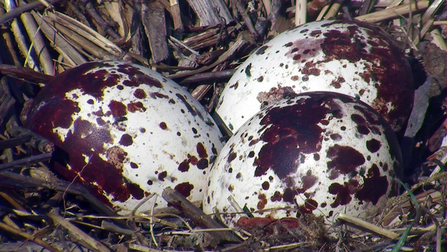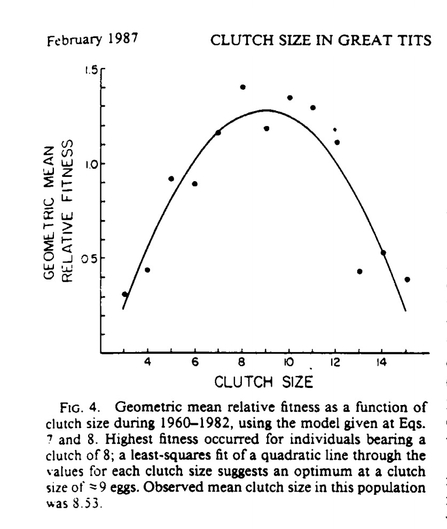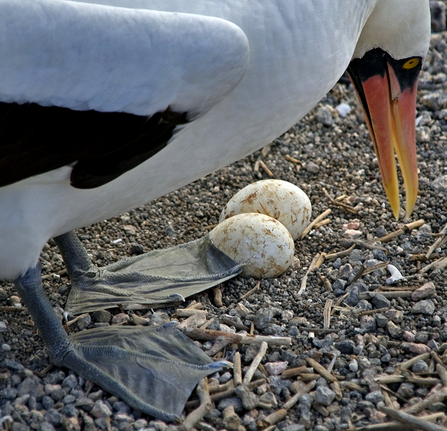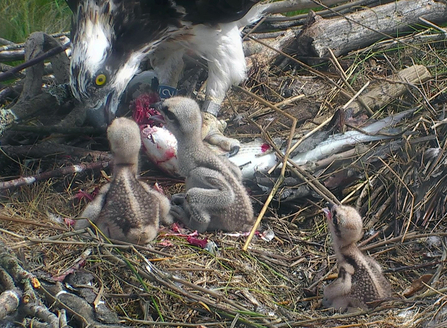You're 10 years old again and you can have as many sweets today as you like.
But there's a catch. You're allowed to take as many sweets as you want from the jar - but only with one hand, one attempt.
You're 10 years old again and you can have as many sweets today as you like.
But there's a catch. You're allowed to take as many sweets as you want from the jar - but only with one hand, one attempt.

So what is your strategy going to be?
Take two sweets and not be greedy, comfortable in the knowledge that you can easily clasp a couple of sweets from the jar in one go? Or does your gluttonous side get the better of you and you try and grab as many as you can? The problem is, by grabbing 10 sweets you risk losing most of them in the bottleneck of the jar on the way out.
Play it safe with two, gamble on 10, or try a strategy that is somewhere in the middle?
Birds face a similar situation with egg clutch size. How many eggs should they lay to guarantee the greatest amount of chicks surviving into adulthood and passing on their genes? Play it safe with one or two, play the numbers game, or go for something in the middle?
Most birds go for "something in the middle" and for ospreys, that number is usually three eggs.
Glesni's three eggs in 2017

But how do birds compute all of this and arrive at a number of eggs that is optimal for them in any particular year and situation?
What criteria are in play here?
FOOD: Clearly food availability plays a big part in determining clutch size. Lay too many eggs and the parents may struggle to feed all of the resulting chicks, especially if a storm comes through and restricts feeding for a day or two.
TIMING: Not too early, not too late, there are pros and cons for both (most 4-clutch ospreys arrive in March).
COMPETITION: Competition from other species and conspecifics for nest sites, food, mates, etc.
FITNESS: The healthier both reproducing adults are, the greater the chance of producing (more) chicks to breeding age.
ENVIRONMENT: Foraging opportunities, disease, parasites, climate, temperatures, suitable nesting sites, all have an effect.
PREDATION PRESSURES: Mammals, reptiles and other birds - all will take eggs/chicks
Of course, no bird makes a conscious decision on how many eggs she will lay. These decisions will have been 'worked out' over thousands and millions of years of evolutionary time, based on the factors at play mentioned above, as well as many others.
Darwinian Natural Selection (or more specifically 'Stabilised Selection' - see here for examples) has computed all the various permutations over time and come up with an answer for each species at any given time and location.
Some species lay exactly the same amount of eggs each year, others lay a range of egg numbers (usually in changing environments). Some species with a wide geographical distribution lay different amounts of eggs depending where in the world they are.
(For more on this, look up r/K Selection Theory: In ecology, r/K selection theory relates to the selection of combinations of traits in an organism that trade off between quantity and quality of offspring)
In the 1980s, Boyce and Perrins published what is now a famous scientific paper on "Optimising Great Tit Clutch Size in a Fluctuating Environment".
They studied the clutch size of great tits nesting in Wytham Wood near Oxford and worked out the optimal number of eggs laid in a sample of almost 4,500 clutches. The answer? Nine eggs.

This is a classic example of a common type of data set we see in ecology. It's called a 'bell curve distribution' or 'student's t-distribution'. Living in a 'fluctuating environment', the great tits laid clutches of between two and 16 eggs, but it was those birds that laid around nine eggs that had the greater fecundity fitness overall on average - in other words, the most amount of chicks surviving into adulthood and breeding age.
So just like young Johnny had to make a decision about which strategy would yield him the most sweets in a one-hand grab of the jar, birds also make a similar decision.
Smaller birds like the great tits above will sometimes have two clutches in one year, so this may also have an effect on clutch size; the equivalent of Johnny being told he has two go's at raiding the sweet jar. Large birds like ospreys get just the one chance at the sweets in the jar. Get it wrong and that's it for another year.
The Nazca Booby in the Pacific always lays two eggs, but only one chick ever survives. Laid five days after the first, the second egg is purely an evolutionary insurance policy.
Nazca booby - never do both chicks make it

If everything works out for the first egg, it hatches and the chick is healthy and grows up strongly, it will eat the second chick soon after it hatches. If something goes wrong with the first egg, however, Bob 2 is there as insurance.
The closely related blue-footed booby also lays two eggs, but this time both chicks have a chance at surviving if environmental conditions are good. If food is plentiful, competition and predation pressures low, there is every chance that both chicks will survive into adulthood. Horses for courses, different types of reproductive strategies in two closely related sea birds.
So how does all this relate to ospreys, and more specifically, Monty, Glesni and Bobby Bach?
Following evolution's long-term experiment of trial & error, ospreys are pre-programmed to lay between two and four eggs, three being (by far) the most common clutch size. Only around one in 20 clutches contain four eggs. So here is our bell-curve distribution graph for osprey egg clutch size then, three (or a fraction close to three) being at the top of the curve.
So, will Glesni feed all three chicks in a fair and equitable way, so that they all get the same amount of food? No, she won't.
Osprey parents will feed the chick that shouts and screams the loudest - usually the stronger of the three if all the eggs hatch. If two chicks are similar or equally as strong (as Bob 1 & 2 are this year), these two will usually receive roughly the same amount of food.
But Bobby Bach, the third chick this year, hatched a whole five days later than its oldest sibling - exactly the same time interval as the two chicks of the Nazca Booby, and we know what happens with these birds...
Bobby Bach - last in line

© MWT
Bobby Bach is also an insurance policy, but this is a good insurance policy that has, if things work out, a decent probability of paying out.
Facultative siblicide (one chick killing an other) is extremely rare in osprey chicks. A three-day old osprey has much more reason to be fearful of a tail-slapping mullet or a clumsy footed parent than it does a big sister eating or killing it.
Osprey chicks fight (see video below), but it's rarely more serious than a bit of handbag throwing. Ospreys that breed in temperate regions such as the UK also have the benefit of what I call Goldilocks weather: Not too hot, too cold, too wet, too dry - just right.
This doesn't always work out of course, as we saw in 2012, but in the main, it does.
So, will Bobby Bach survive?
Right now there are probably a couple of hundred Bobby Bachs scattered around various ospreys nests in the UK. Two hundred insurance policies that will hopefully pay out if conditions are more Goldilocks than extreme.
There's every reason to think that our third chick this year will make it. The 10-day weather forecast looks good, predation pressures are low, as is competition from other ospreys, including food sharing within polygamous nests (Blue 24 is a mere spectator this year, Monty is not supplying her with fish).
Glesni and Monty will still keep on feeding the strongest chicks first - they are programmed to do this, but just like the blue-footed booby, if there is enough food to go 'round, all the chicks will get enough to eat and have a good stab of making it to Africa in September.
Ice Cream
You can play this game at home. Next time you hear the Greensleeves chimes of the ice cream van getting louder, pop outside and see how many 99s you can safely carry in one hand. You can't use both hands, you have to pay with the other. An albatross would not gamble and take one, a great tit would take nine. Do you play safe and take one or take several and risk the lot collapsing in on each other?
The Albatross strategy

Remember, if you're watching the Live Streaming, it may appear as if Bobby Bach is not getting as much to eat as the others. But right now he doesn't need as much as the other two as he's quite a bit smaller. If Monty catches enough fish, Bobby Bach always gets his turn - eventually.